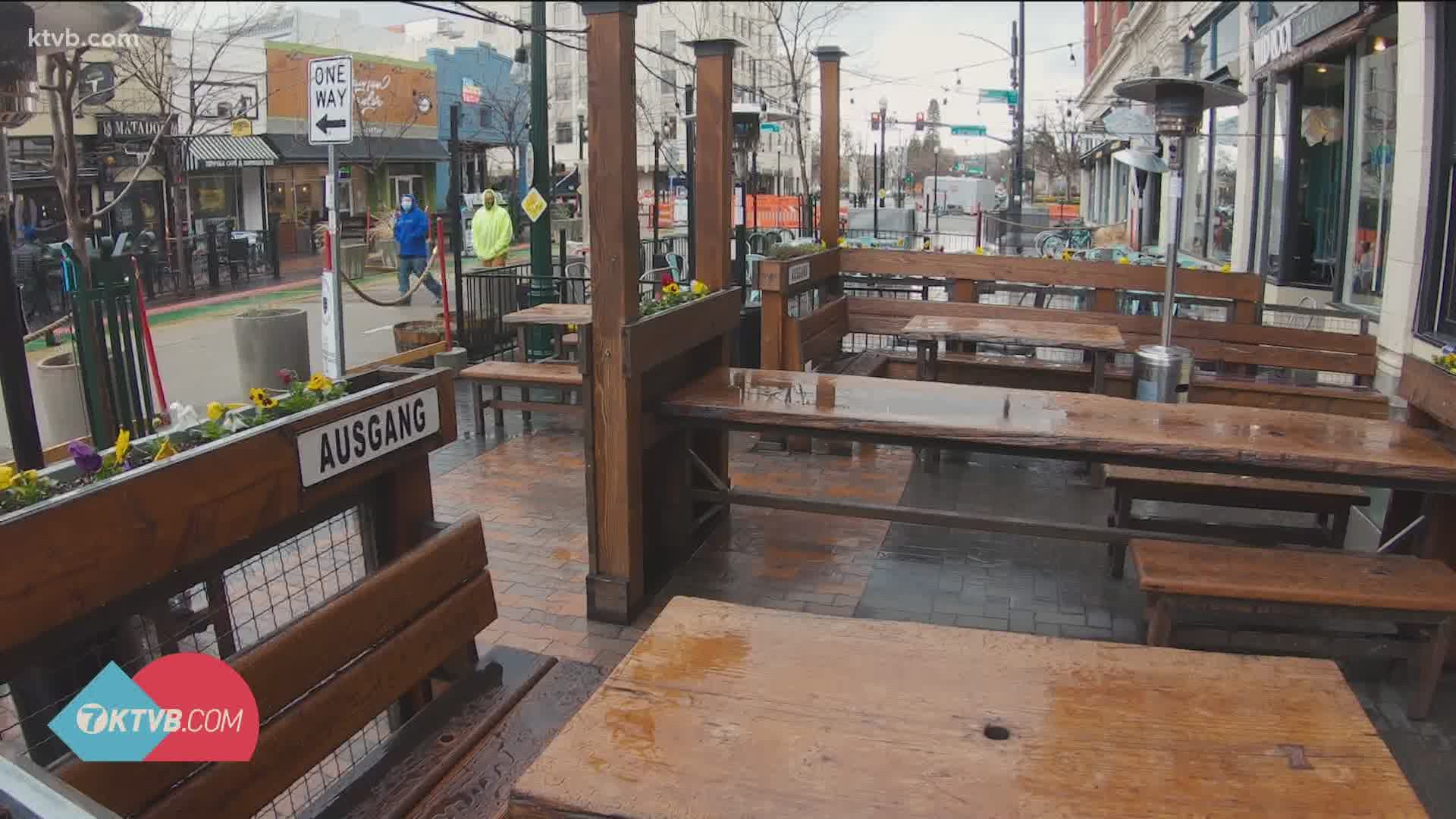BOISE, Idaho — As of Thursday, it's been exactly one year since Idaho Gov. Brad Little issued his stay-at-home order as COVID-19 cases began to climb in the Gem State and the pandemic became a harsh reality for many Idahoans.
The order, issued on March 25, 2020, required all non-essential businesses to shut down and Idahoans to stay home for three weeks. The order was later extended to more than a month.
The hope was to help stop or at least slow down the spread of the novel coronavirus within the community. Schools, restaurants, gyms, theaters, bowling alleys, and bars all closed to any sort of in-person participation.
Things we need, like groceries, gas, and emergency medical services were still accessible.
Downtown Boise, normally a bustling center of commerce in the city, became a virtual ghost town. Playground equipment in city parks was taped off, and popular spots like JUMP, Rhodes Skate Park and many more were left vacant.
The governor's stay-at-home order was eventually lifted on May 1, allowing the majority of businesses to reopen.
But during those 31 days, there was a lot of confusion and controversy over what was considered an "essential" business.
First and foremost, the word "essential," while accurate, was a rather touchy word to use because it gave critics an avenue to tyranny, with some asking, how can the government deem my business, my job not essential? It's essential to me, to my family, to my livelihood.
The term stirred up a lot of debate throughout Idaho. In fact, when that stay-at-home order was announced, the governor's office sent out a three-page list of what the state considered essential and could remain open.
People had to get their groceries and gas, make their medical and dental appointments. But even that list didn't clear up a lot of the questions.
One day after making the order, Gov. Little visited the KTVB studio - this is before virtual interviews became a thing - to talk about the specifics.
We asked him about different types of businesses - like pawn shops, tobacco stores, and construction jobs - that were not included specifically on the list. The governor struggled to answer a lot of the questions, because many of the businesses fell into gray areas, especially when it comes to the term, "essential."
Ultimately, there wasn't a whole lot of clarity as we set out to get control of a highly contagious virus. State leaders were trying to figure it out on the fly and fast.
Eventually, places like restaurants, schools, and gyms evolved and came up with ways to reopen, without opening completely. We leaned into delivery and take-out, took advantage of curbside service, and hung masks from rear-view mirrors. We added remote-learning to our lexicon and we learned Zoom wasn't just a catchphrase for a car commercial.
Not that it wasn't without setbacks. As the state re-opened in phases, places like bars and nightclubs - at least in Ada County - were forced to shut down again over the summer as a second wave of cases hit.
Even as we got into the fall, there were continued questions about gyms and schools. But they were allowed to remain open - with restrictions. And yes, we eventually figured out the difference between what we needed, versus what we wanted, in a health crisis - essential versus non-essential in a precarious pandemic.
So what has it been like for those "non-essential" businesses during the last year?
Some have been on an almost never-ending cycle of closing, reopening, and then closing again - specifically places like bars and restaurants - depending on the governor's current stage of reopening and the strain on local hospitals.
As cases dropped, those businesses were told they could open - with restrictions like mask requirements, limits on occupancy and earlier closing times.
Some have had to adapt their business models and most still require masks and social distancing.
Unfortunately, some businesses in one of Idaho's biggest economically-booming locations, couldn't survive the ups and downs.
Of the 300 street-level businesses overseen by the Downtown Boise Association, 27 have permanently closed their doors since January of 2020. That's about 10%. Of those, 16 closed because of the pandemic.
On the flip side, DBA says 43 new businesses have opened in downtown Boise during that same time frame and another 16 are slated to open soon.
Now let's compare those numbers to a normal year - 2019, for example. At the end of that year, 19 downtown Boise businesses had closed. But the growth was a little less with 34 new businesses opening and 12 on the way. So the turnover in 2020 was higher than in 2019.
DBA says those numbers do not include the upper-floor offices they oversee, so numbers may skew differently.
One year later, some businesses are still not back to full capacity. Some continue to offer reduced hours, and reduced capacities to give customers room to move around comfortably.
The bright side of seeing the light at the end of the pandemic tunnel is that there are more businesses opening in downtown Boise - so the pandemic was not a death knell for the popular area of town.
Join 'The 208' conversation:
- Text us at (208) 321-5614
- E-mail us at the208@ktvb.com
- Join our The 208 Facebook group: https://www.facebook.com/groups/the208KTVB/
- Follow us on Twitter: @the208KTVB or tweet #the208 and #SoIdaho
- Follow us on Instagram: @the208KTVB
- Bookmark our landing page: /the-208
- And we also turn each episode into a podcast or Podbeam
- Still reading this list? We're on YouTube, too:

